One of the most endearing and enchanting of our local wildlife species has to be the deer, especially when they are fawns.
The black-tailed deer are the only deer species found on Vancouver Island but other deer species inhabit the coastal mainland, Vancouver and the Fraser Valley.
Each year during the winter months MARS receives many deer-related inquiries: "Why do they look so mangy?" "Why are they eating plants they don't usually touch?" "There's a dead deer in my shed," and tragically, "What should I do when a deer is hit by a car?"
Deer have inhabited our area long before we came along foraging on native shrubs and plants and also in natural grasslands. With urban development and the introduction of farmlands and non-native plants, shrub and trees deer habits are changing along with their habitat.
It is not an unusual sight in our local areas to see a herd of deer grazing alongside a herd of cows sharing the same field. In addition, urbanization has replaced their local habitat with parks and backyards complete with a cornucopia of fresh plants, flowers, apples and many tasty morsels they try for the first time. only to spit out uneaten.
The number of pristine golf courses has also provided the deer with a safe habitat away from natural and domesticated predators where they can raise their fawns in relative safety.
However, the increased human contact has posed a set of new problems.
They are either being encouraged to spend more time around homes and rely for supplemental food, or they are facing dangers posed by humans and our dependence on vehicles to transport us to work or play.
The B.C. Ministry of Environment has published a guideline to answer some of the more common questions that are asked, and to offer advice on how to deal with the poor health that seems to plague many of the deer especially the young in the winter months.
Some of the following indications may signify a deer in distress.
• Loss of fear around humans;
• Weakness and hanging out around homes, porches or in outbuildings;
• Poor to extremely thin body condition;
• Poor condition of coats, missing tufts or large patches of hair;
• Digestive upsets — obvious diarrhea, liquid feces or impacted feces;
• Dead deer from no apparent cause.
MARS now has a special fawn enclosure where we can care for orphaned fawns. Once they are weaned they are transferred to another temporary home until they are released back into the local herd.
To better understand the stresses of fawns raised in a captive situation last year, we tagged the 2012 fawn's ears with yellow identifying numbers A1-A12. This year there will be a series of B numbers.
This information will be passed along to the ministry, which is tracking the health of local wildlife species. If you see one, call us with the number and location. Please remember that adult deer can become aggressive if cornered by humans or if a dog or human comes between the doe and her fawn.
If you hit or see a deer hit on the road, where possible, try to move it to the side and report it to the RAPP line at 1-877-952-7277 or Emcon at 250-336-8897. If the deer dies on your property, you are responsible for its disposition.
Deer are truly beautiful animals and with more understanding, we can live in harmony with each other keeping them wild and healthy. Please visit our website to follow our patient's progress and find out what special events are happening in your community.
To report injured wildlife, call 1-800-304-9968. For more information, visit www.wingtips.org.
Sandy Fairfield is the educational co-ordinator for the Mountainaire Avian Rescue Society (MARS). The MARS column appears every second Friday.
